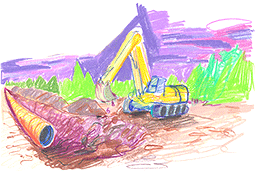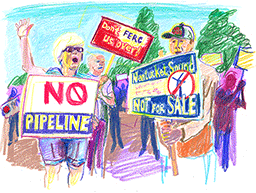
Untangling Complexity
Designing for Shared Understanding
By Jacqueline Wallace
The next phase of the digital revolution will be defined by products and services that facilitate shared understanding, allowing concerted participation around complex issues. In working to show the way, civic designers will need to call upon the powers of systems research, design research, social science, and open data.
In early 2014, community members of the small town where I reside in Western Massachusetts began reporting that employees of Kinder Morgan, a privately owned energy infrastructure and transportation company, were knocking on doors requesting permission to survey their properties. At a local town hall meeting, our suspicions were confirmed: Kinder Morgan planned to construct a high-pressure natural gas pipeline right in our collective backyard.
Residents quickly convened in order to better understand Kinder Morgan’s proposal but were confronted by unimaginable complexity. For one thing, myriad organizations—including the Federal Energy Regulatory Commission, the State of Massachusetts, and Kinder Morgan itself—were already involved in the issue. For another, community members hadn’t learned about the pipeline until Kinder Morgan’s approval process was well underway. If residents were going to act, we needed to act fast.
As the problems confronting 21st century citizens grow in complexity, citizens require not only the means to understand those problems but also the means to exert political power over them. Activism on our part will require clear communication and shared understanding1. Organizers before us may have leveraged Twitter and Facebook for civic effect, but civic designers will need to take this to the next level by creating products that enable citizens to collectively understand—and act upon—the layered, oftentimes opaque information surrounding complex issues.
Creating next-gen civic applications will require designers to embody a systems-based approach to civic participation, marrying systems-based research, user-centered design, social science, and data. This article chronicles my own experience leveraging these tools to facilitate shared understand amongst my community vis. a vis. the Kinder Morgan pipeline.
The opposite of simple
Complex—or “wicked”—problems are those for which no obvious solutions present themselves2. Because the actors comprising social systems actors tend to see things in different, occasionally contradictory ways, these problems often manifest inside complex social systems.

In the case of the proposed Kinder Morgan Pipeline, the following actors comprised the intersection of our community’s social system and our community’s energy ecosystem:
- the fracking companies that extract gas out of the earth’s crust;
- the infrastructure companies that process and ship gas;
- the utility companies that manage the power grid and deliver electricity to the communities, homes and businesses that use it; and
- the federal, state and local agencies who oversee the process.
Looked at this way, it’s easy to see how any proposed change to the current energy ecosystem would be frowned upon by at least one actor.
Far worse than this, however, were the ways in which actors chose to exert political power whenever change was proposed; uneven distributions of political power dramatically affected any given actor’s ability to sway others in their favor3. In the weeks that followed the first news of the pipeline, I witnessed various individuals—arguing both for and against it—working to expand their influence. This resulted in an environment in which independent citizens struggled to orient themselves politically.
To help bring clarity to the matter, I sought to articulate a thoughtful narrative of change by incorporating user-centered research and systems research into the conversation.
User research
User research draws upon the rich traditions of ethnography, sociology, and design thinking in order to inform a designer’s understanding of the context in which their designs will be used. In my case, I sought to better understand my community members’ perspectives in order to paint a picture of the larger conversation taking place.
I started by grouping actors by their existing behaviors. They included:
- Energy consumers: grassroots activists, property owners, and citizens;
- Energy producers: Kinder Morgan, local utility companies, and labor unions;
- Energy regulators: local, state, and federal commissions and agencies; and
- Energy experts: academics who could provide technical insight.
I then set about interviewing people that fell into these behavior-based categories.
My interviews produced insights both wonderful and unexpected. Grassroots activists, for example, were adamant that the pipeline wasn’t necessary because Massachusetts could meet its energy needs with wind energy, hyrdo-power and other renewables. The director of the University of Massachusetts’ Wind Energy Program, however, explained that he saw very little hope for wind energy in New England—only 5% of Massachusetts’s electricity is created by wind power (whereas over 50% is provided by natural gas). Why is wind such an insignificant source of New England’s energy system? It turns out that when wind turbines were proposed in the area, local citizens rallied against them. In fact, many of the leaders of the past anti-wind movement were leading the anti-pipeline movement today. “Wind, in this area,” he said, “is dead.”
My interviews shed light on pieces of our energy system’s history that were obscured from popular view. Yet, as systems thinker Donella Meadows reminds us, understanding history is crucial to understanding how a system works: “before you disturb the system in any way, watch how it behaves…If it’s a social system, watch it work, learn its history. Ask people who’ve been around a long time to tell you what has happened4.”
My understanding of the Kinder Morgan pipeline grew in lockstep with the number of people I interviewed; the questions I was capable of asking—and the depth of conversations that I was capable of maintaining—evolved over time. I became acutely aware of the fact that many of the people with whom I spoke didn’t understand the Kinder Morgan pipeline nearly as much as their passion in fighting against (or for) it led me to believe5. Thus, I experienced one of user research’s most poignant limitations: Users often fail to realize they’re simply looking at the present moment of a process that began a long time ago.
User research alone can’t help designers understand sufficiently complex problems. In order inform our approach, we’ll need to cast a wider net by incorporating methodologies that break through the boundaries of individual worldviews.
Systems research
We ought to ask ourselves at the very outset how to think about a large system, and our manner of thinking will dictate how we will describe the system. Some descriptions of the system are not obvious at all. There are ways of describing systems that would not occur to most people who tend to look at the world in one way, namely the way familiar to them. The systems approach will…suggest some radical approaches to thinking.
C. West Churchman, The Systems Approach
Systems researchers are learners who grow their understanding by looking for links between artifacts, reports, and other sources of information. They develop a working knowledge of the system by learning its vocabulary, thinking about its history, and identifying its levers for change.
My systems-based inquiry into the Kinder Morgan pipeline unfolded across two avenues. First, I read a study alluded to by one activist I met during my user research. Commissioned by the New England States Committee on Electricity (NESCOE) and executed by the energy consulting company Black & Veatch, the study presented three future scenarios of New England’s energy needs. It plainly stated that in two out of the three scenarios, a natural gas pipeline would be required to keep electricity prices at reasonable levels. NESCOE, in addition to (what was then) six New England governors, all came out in support of the pipeline following the release of the study. Like a trail of breadcrumbs, the study’s content opened up a world of questions and answers to me.
The second avenue I pursued was, simply, Google Alerts6. After briefly configuring the service, I was constantly apprised of pipeline-related events and information that were often left out of the local narrative.
My brief foray into systems research provided me with a level of understanding I would have never achieved if I had relied on user-centered interviews and observations alone. Yet systems research is often overlooked by the design industry. Designers constantly fall into the trap of believing that simple, user-centered thinking will create simple, easy-to-use products. My experience shows otherwise.
Complexity only exists as a problem because we avoid developing ways to dissolve it. As system scientist C. West Churchman warned, “when you postpone thinking about something too long, then it may not be possible to think about it adequately at all7.”
Findings
The synthesis of my research depicted a large, complex system populated by participants who struggled to conceive of change and articulate their desires. Many people rested on their fears.
Here are some of the key tensions I observed:
-
Timelines
The process through which the Federal Energy Regulatory Commission (FERC) might grant Kinder Morgan approval to build the pipeline and execute eminent domain would unfold through a series of steps. Because FERC is a federal agency, all documents would be published online and available for public comment. Citizens had little understanding, however, of the processes by which they could participate. They were unaware of the important role their comments played on these documents and in the complicated legal processes driving the pipeline’s approval.
-
Muddled activism
Despite the fact that the anti-pipeline movement gained a great deal of momentum during the course of my research, their core argument against the pipeline held very little credibility due to the region’s anti-wind history. This was a clear disconnect between citizen activists and policy consultants: citizen activists were often ignorant of the region’s history, whereas policy consultants were well aware of it. The disconnect between the two resulted in a situation in which the time and energy of citizen activists was misdirected—they were advocating for a dead issue. As one policy expert stated in regards to activist leaders, “they need to have some intellectual honesty.”
-
Governance
Fears surrounding the pipeline were so overwhelming that no one cared to understand how it would be managed, operated or used. Yet my research suggests that pipeline management is critical; the rules that govern its use are almost as important as the pipeline itself. This means that citizens could take a stronger position against the pipeline if they analyzed the rules driving the economics of its operation and management.
-
Disconnected representatives
Believe it or not, many representatives relied on word of mouth to learn about the pipeline. At a conference, one Massachusetts State Senator criticized the lack of a centralized information system that alerted elected representatives to these issues or their status. Representatives at the conference frequently expressed a clear need to understand the issues their constituents cared about.
I eventually delivered my research on the pipeline to the public as a series of written articles8. Yet Kinder Morgan’s proposed pipeline continues to elicit drama. While the company hopes to obtain approval for its pipeline’s construction in 2015, many Massachusetts citizens have persisted in rallying against it. And they’re not alone. Protest movements against other Kinder Morgan pipelines are being carried out in New York, Canada, and elsewhere.

A call to action
I believe the contention around the pipeline evinces a bigger problem in our civic sphere: While individual issues such as the Kinder Morgan pipeline continue to absorb a great deal of energy from citizens, user-centered designers must use their unique skillset to address these issues more broadly. Because we’re not only failing our fellow citizens; we’re failing our representatives as well. In the words of digital strategist and civic design advocate Mike Connery: “there has been almost zero investment in giving our representatives the tools they need to understand feedback from citizens.”
The opportunity is two-fold. As previously stated, there is a need to develop tools that support citizens and representatives to understand and engage with complex social issues. There is also a need to develop processes, processes that cultivate our abilities to understand policy development in order to more efficiently spend our tax dollars. Writing about a recent project that used social science methods to analyze the long-term success of a welfare project, NPR correspondent Shankar Vedantam said, “it really makes no sense that marketers selling toys have better data on what works and what doesn’t than policy makers who are spending billions and billions of dollars.”
Perhaps we’ve struggled to build tools that track our tax dollars because we’ve lacked a guiding light. If that’s the case, I’d like to suggest that we consider the disciplines of design research, systems research, computational social science, and policymaking for inspiration: design researchers and ethnographers excel at understanding and communicating the human experience; social scientists and data scientists are experts at identifying patterns in complex data sets and surfacing social phenomena; and systems researchers and policymakers are able to analyze political processes from a 1,000 mile view. Designers make complex digital systems more intuitive and pleasurable. By forging the offerings of these research processes, we can produce findings that serve as jumping off points for meaningful creative work.
We’re beginning to see evidence of traction in this space. Micah Sifry explored some initiatives in his piece “Civic Tech and Engagement: In Search of a Common Language”. Additionally, MIT Media Lab’s Human Dynamics research group in Trento, Italy —in concert with several other organizations—have studied the relationship between behavioral data and social dynamics for over two years. Their project, the Mobile Territorial Lab, is, in the words of Bruno Lepri, the Lab’s leader, “a living lab, these people are dealing with real-life problems. We try to design solving for them.”
Like a set of case studies, each project discussed by Sifry and Lepri brings a unique mix of interdisciplinary methodologies to civic design. Still in experimental stages, the projects are testing hypotheses and designing experiments to understand what works and what doesn’t at the intersection of digital tools, social issues and civic engagement. In doing so, they may be charting a course for the next iteration of meaningful democratic participation through design and technology.
Footnotes
-
Malcolm Gladwell, “Small Change,” New Yorker, October 4, 2010
Return -
Richard Buchanan, “Wicked Problems in Design Thinking,” Design Issues (1992) The MIT Press; vol 8, no 2.
Return -
Whenever systems have high levels of complexity and low levels of transparency, it becomes possible for those with a greater degree of political power to subversively expand their influence.
Return -
Donella Meadows, Thinking in Systems: A Primer (Vermont: The Sustainability Institute, 2008).
Return -
There was a great deal of NIMBY (Not In My Backyard) activism, which is problematic due to the fact that there are over 2 million miles of natural gas pipelines in the US, meaning that there are many people with pipelines running through their property and community’s. Community infighting is also a strategic tactic used by energy companies to distract communities from pipeline approval processes.
Return -
Google Alerts is a service that sends users alerts based on newly indexed content matching terms they specify. Once I specified an alert for “pipeline data,” for example, Google sent me a daily email with links to anything newsworthy regarding pipeline data. This alert was sometimes very fruitful, as it gave me access to technological and data driven innovation in the energy sector. It was also problematic in that it included articles about “data-pipelines.” These are very different things. It often takes a few tries to find the correct terminology.
Return -
C. West Churchman, The Systems Approach, Delacorte Press, New York, 1968, pg 8
Return -
Interested readers should contact me at hello@jacqueline-wallace.com.
Return
Like this kinda stuff?
Consider donating to help us to continue doing this work! We also encourage reader comments via letters to the editor.
 Jacqueline Wallace is a researcher and design strategist exploring design’s role in facilitating social change. She works as an interactive producer for Knectar Design out of New York City and Northampton, MA.
Jacqueline Wallace is a researcher and design strategist exploring design’s role in facilitating social change. She works as an interactive producer for Knectar Design out of New York City and Northampton, MA.